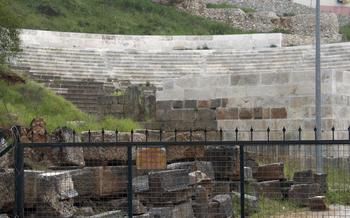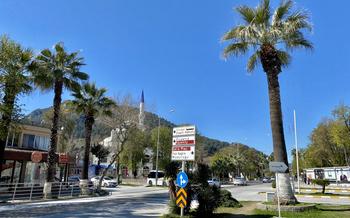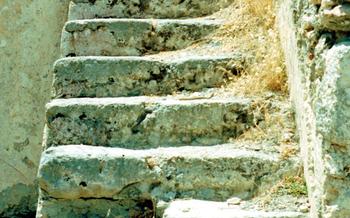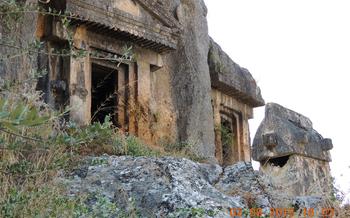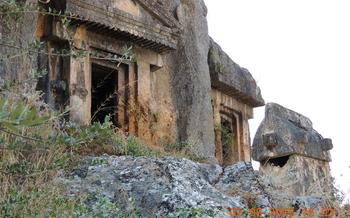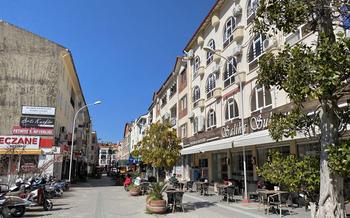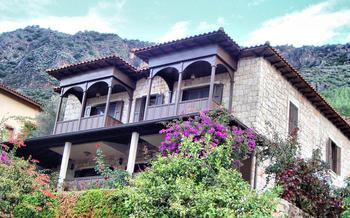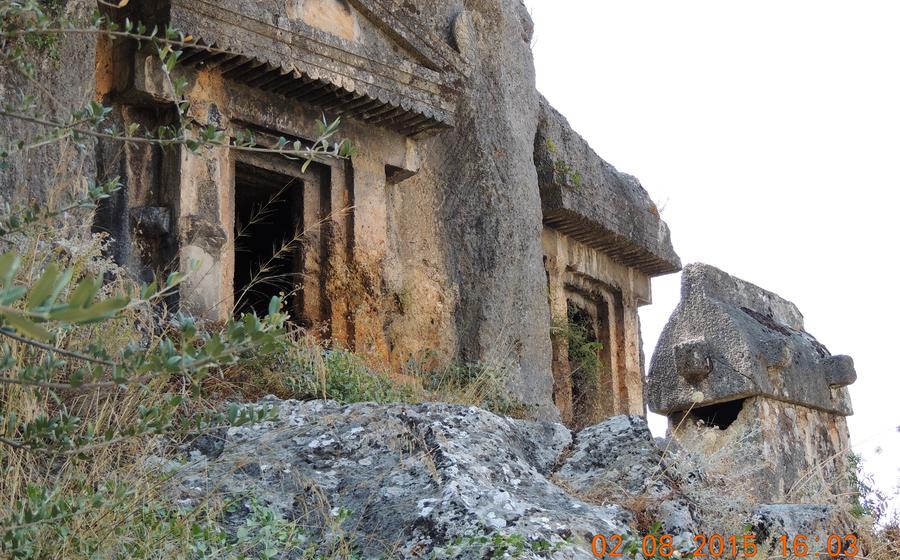
Fethiye Lycian Rock Tombs
- Fethiye Lycian Rock Tombs: A Journey into Ancient History
- Unveiling the Ancient City of Telmessos
- Exploring the Necropolis: A Walk Through Time
- Tomb of Amyntas: A Majestic Masterpiece
- Tomb of the Nereids: A Monument to Grace and Beauty
- Tomb of the Harpies: A Realm of Mystery and Intrigue
- Panoramic Views from the Acropolis
- Ancient Theater of Fethiye: A Stage for History
- Rock-Cut Cisterns: Engineering Marvels
- Exploring the Fethiye Museum: A Treasure Trove of History
- Strolling Through the Old Town: A Journey Through Time
- Fethiye Fish Market: A Culinary Adventure
- Boat Trips to Hidden Bays and Islands
- Insider Tip: Off-the-Beaten-Path Explorations
Fethiye Lycian Rock Tombs: A Journey into Ancient History
The Lycian Rock Tombs in Fethiye, Turkey, are a testament to the rich history and cultural heritage of the ancient Lycian civilization. These impressive tombs, carved into the sheer rock face of the mountains, offer a glimpse into the lives and beliefs of this fascinating people.
The Lycians were a seafaring people who inhabited the southwestern coast of Anatolia from around 1500 BC to 300 BC. They were skilled navigators, traders, and warriors, and their culture was influenced by a blend of Greek, Persian, and Anatolian traditions.
The rock tombs, which date from the 4th to 6th centuries BC, were built as elaborate resting places for the Lycian elite. The tombs are adorned with intricate carvings and reliefs depicting scenes from mythology, hunting, and everyday life. These carvings provide valuable insights into Lycian art, symbolism, and religious beliefs.
The tombs are located just a short distance from the center of Fethiye, making them easily accessible for visitors. The site is open to the public, and visitors can explore the tombs and admire the impressive craftsmanship up close.
The Fethiye Lycian Rock Tombs are a must-see for anyone interested in ancient history, archaeology, or culture. These awe-inspiring monuments offer a unique opportunity to step back in time and experience the world of the ancient Lycians.
Unveiling the Ancient City of Telmessos
The ancient city of Telmessos, once a thriving port city and the capital of Lycia, lies buried beneath the modern city of Fethiye. Archaeological excavations have revealed a wealth of artifacts and ruins, providing glimpses into the rich history and culture of this ancient metropolis.
Telmessos was founded in the 5th century BC by the Lycians, an Anatolian people known for their seafaring skills and their unique culture. The city quickly rose to prominence as a major trading hub, connecting the Lycian coast with the rest of the Mediterranean world. Its strategic location at the mouth of the Fethiye Gulf also made it an important military stronghold.
In the 4th century BC, Telmessos fell under the rule of Alexander the Great, who incorporated it into his vast empire. After Alexander's death, the city became part of the Ptolemaic Kingdom of Egypt, and later the Roman Empire. During the Roman period, Telmessos flourished as a center of trade and culture, reaching the height of its prosperity.
The ruins of Telmessos are scattered throughout the modern city of Fethiye. The most significant remains include the ancient theater, the city walls, and the necropolis, which houses the famous Lycian rock tombs. These ruins offer a glimpse into the grandeur and sophistication of this ancient city, which once played a vital role in the history of the Mediterranean region.
Exploring the Necropolis: A Walk Through Time
The necropolis of Fethiye, located on a hillside overlooking the city, serves as a window into the rich cultural heritage of the Lycians. Spread across a vast area, the necropolis consists of numerous rock-cut tombs, each unique in design and style. Visitors can embark on a captivating journey through time as they explore the various types of tombs, from simple chamber tombs to elaborate temple tombs.
The necropolis showcases the Lycians' mastery of rock-cut architecture. Tombs are carved directly into the rocky cliffs, creating impressive facades adorned with intricate carvings and reliefs. These carvings often depict scenes from mythology, religious beliefs, or everyday life, providing valuable insights into the Lycian culture. The necropolis is a testament to the skill and artistry of the Lycian craftsmen, who transformed the natural landscape into a sacred burial ground.
The variety of tomb types reflects the social hierarchy and customs of the Lycians. Simple chamber tombs, consisting of a single room, were likely used for ordinary citizens. More elaborate temple tombs, featuring multiple chambers and adorned with elaborate carvings, were reserved for the wealthy and influential members of society. The diversity of tomb types offers a glimpse into the social structure and values of the Lycian civilization.
Exploring the necropolis is a unique and immersive experience, allowing visitors to connect with the past and gain a deeper understanding of the Lycian civilization. The tombs serve as silent witnesses to the lives, beliefs, and customs of this ancient people, offering a glimpse into their world and the legacy they left behind.
Tomb of Amyntas: A Majestic Masterpiece
Amidst the ancient Lycian rock tombs, the Tomb of Amyntas stands as a testament to architectural grandeur and historical significance. This impressive structure, dating back to the 4th century BC, is a marvel of ancient engineering and artistry.
The tomb's imposing façade, carved into the rocky hillside, features intricate carvings and reliefs that depict scenes from Greek mythology and Lycian history. These intricate details showcase the skill and artistry of the Lycian craftsmen who created this masterpiece.
The interior of the tomb is equally impressive, with a spacious chamber adorned with elaborate wall paintings and bas-reliefs. These artworks illustrate scenes from the life of Amyntas, a prominent Lycian ruler, and provide valuable insights into the culture and customs of the Lycian civilization.
The historical significance of the Tomb of Amyntas extends beyond its architectural beauty. Amyntas was a powerful and influential ruler who played a crucial role in shaping the political and cultural landscape of ancient Lycia. His tomb serves as a reminder of the rich history and legacy of this ancient civilization.
When visiting the Fethiye Lycian Rock Tombs, be sure to take some time to explore the Tomb of Amyntas. This awe-inspiring monument offers a glimpse into the past and provides a deeper understanding of the Lycian civilization's artistic achievements and historical significance.
Tomb of the Nereids: A Monument to Grace and Beauty
The Tomb of the Nereids stands as a testament to the artistic prowess and cultural achievements of the Lycians. This magnificent structure, dating back to the 4th century BC, is adorned with exquisite sculptures and bas-reliefs that depict mythological scenes and figures. The tomb's architectural style is a blend of Greek and Lycian influences, showcasing the region's rich cultural heritage.
The Nereid Monument, as it is also known, features a rectangular base adorned with intricate carvings of Nereids, mythical sea nymphs. These graceful figures, depicted in flowing robes, symbolize the transition between the mortal and divine realms. The tomb's frieze showcases a continuous narrative, narrating tales from Greek mythology, including the Trojan War and the adventures of Bellerophon.
The Tomb of the Nereids is a true masterpiece of ancient Lycian art. Its exceptional craftsmanship and artistic vision have earned it widespread recognition as one of the most significant and well-preserved funerary monuments in the region. The tomb's enduring beauty and historical value continue to captivate visitors, offering a glimpse into the artistry and cultural traditions of ancient Lycia.
Tomb of the Harpies: A Realm of Mystery and Intrigue
Among the impressive rock tombs of Fethiye, the Tomb of the Harpies stands out with its unique features and enigmatic aura. Its architectural style and decorative elements invite speculation and theories about its history and symbolism.
The tomb's façade is adorned with intricate carvings depicting mythical creatures known as harpies. These half-woman, half-bird figures hold aloft a frieze with relief sculptures portraying scenes of daily life, hunting, and feasting. The symbolism of the harpies, often associated with death and the underworld, adds to the mysterious atmosphere surrounding the tomb.
The interior of the tomb is equally captivating, with a series of chambers and niches that once housed sarcophagi. The walls are adorned with bas-reliefs depicting scenes from Greek mythology, including the story of Bellerophon and the Chimera. These elaborate carvings offer a glimpse into the beliefs and cultural influences of the Lycians.
The exact identity of the individuals buried in the Tomb of the Harpies remains unknown, fueling speculation about its historical significance. Some theories suggest that it may have been the tomb of a wealthy Lycian family or a prominent figure from the city of Telmessos. Others believe it may have served as a communal tomb for multiple individuals.
Regardless of its original purpose, the Tomb of the Harpies remains a testament to the artistic prowess and cultural heritage of the Lycian civilization. Its unique features and intriguing symbolism continue to captivate visitors, inviting them to delve deeper into the mysteries of this ancient realm.
Panoramic Views from the Acropolis
The acropolis of Telmessos, perched atop a hill overlooking the Fethiye Gulf, offers breathtaking panoramic views that are sure to leave you awestruck. As you ascend the hill, the landscape gradually unfolds before your eyes, revealing a mesmerizing tapestry of azure waters, lush green hills, and distant mountains. The Fethiye Gulf, with its tranquil turquoise waters and intricate coastline, takes center stage, beckoning you to explore its hidden coves and secluded bays.
From the hilltop, you can survey the surrounding countryside, dotted with olive groves, vineyards, and traditional Turkish villages. The ruins of the ancient city, with its well-preserved theater, fortifications, and rock-cut tombs, provide a glimpse into the rich history of this region. As the sun begins to set, the sky transforms into a canvas of vibrant colors, casting a golden glow over the landscape. Whether you're a history buff, a nature enthusiast, or simply seeking breathtaking views, the acropolis of Telmessos is a must-visit destination in Fethiye.
Ancient Theater of Fethiye: A Stage for History
Amidst the ruins of ancient Telmessos, the Ancient Theater of Fethiye stands as a testament to the city's rich cultural heritage and vibrant social life. Constructed in the Hellenistic period and expanded during the Roman era, this impressive theater once hosted a variety of performances and events that entertained and captivated audiences.
The theater's well-preserved remains reveal its architectural grandeur and meticulous design. Its tiered seating arrangements, capable of accommodating thousands of spectators, offer a glimpse into the communal experiences and social interactions of ancient times. The stage, adorned with intricate carvings and decorative elements, served as a platform for theatrical performances, musical concerts, and oratorical contests.
The theater's acoustics are remarkable, ensuring that even the faintest whispers from the stage could be heard throughout the auditorium. This acoustic marvel allowed actors, musicians, and orators to connect with their audience on a profound level, creating an immersive and engaging atmosphere.
Beyond entertainment, the theater served as a significant civic and social hub. It was a place where citizens gathered to celebrate festivals, discuss important matters, and witness official ceremonies. The theater's presence in the heart of the city underscores its role as a central meeting point where people from all walks of life came together to share in collective experiences.
Today, the Ancient Theater of Fethiye stands as a testament to the enduring legacy of ancient Greek and Roman culture. Its ruins, weathered by time yet still majestic, invite visitors to step back in time and imagine the vibrant performances and events that once brought this ancient stage to life.
Rock-Cut Cisterns: Engineering Marvels
Descending beneath the surface of Fethiye reveals a hidden network of rock-cut cisterns, a testament to the ingenuity and engineering prowess of ancient civilizations. These underground water reservoirs, carved into the bedrock, served as vital water storage systems for the thriving communities of the past.
The cisterns showcase remarkable construction techniques, employing vaulted ceilings and intricate channeling systems to collect and store rainwater. These subterranean chambers provided a reliable water source during dry seasons and droughts, ensuring the survival and prosperity of the city's inhabitants.
Exploring these ancient cisterns is a journey into the depths of history, revealing the remarkable engineering skills and foresight of our ancestors. Their ability to harness and manage water resources in such an efficient and sustainable manner continues to inspire and amaze visitors to this day.
Exploring the Fethiye Museum: A Treasure Trove of History
The Fethiye Museum is a captivating journey through the rich cultural heritage of Fethiye and its surrounding regions. Housed in a historic building, the museum showcases a diverse collection of artifacts from the Lycian era and beyond. As you step inside, you'll be greeted by an array of sculptures, ceramics, and inscriptions that tell the story of this ancient civilization.
Among the highlights of the collection are intricate sculptures depicting gods, goddesses, and mythical creatures. These masterpieces offer a glimpse into the religious beliefs and artistic traditions of the Lycians. The museum also houses a collection of ceramics, including pottery, vases, and amphorae, providing insights into the daily lives and craftsmanship of the ancient inhabitants.
In addition to the Lycian artifacts, the museum also features exhibits from other periods of history, including the Hellenistic, Roman, and Byzantine eras. These artifacts shed light on the diverse cultural influences that have shaped the region throughout the centuries.
A visit to the Fethiye Museum is a must for anyone interested in the history and culture of Fethiye and its surroundings. It's a place where you can delve into the past and discover the stories that have shaped this fascinating region.
Strolling Through the Old Town: A Journey Through Time
The old town of Fethiye is a vibrant tapestry of history, culture, and local charm, inviting visitors to embark on a journey through time. As you wander through its narrow cobblestone streets, you'll be greeted by an array of historical landmarks, hidden gems, and bustling local markets.
The old town's architecture is a testament to its rich past, with traditional Ottoman-style houses and buildings lining the streets. Admire the intricate details of these structures, with their colorful facades, wooden balconies, and arched doorways. Each building tells a story, whispering secrets of the town's bygone era.
Strolling through the old town, you'll stumble upon hidden gems tucked away in unexpected corners. Discover charming cafes nestled amidst fragrant flower pots, where you can sip on Turkish coffee and savor the slow pace of life. Explore local shops selling handmade crafts, textiles, and souvenirs, where you can find unique treasures to take home as mementos of your visit.
The heart of the old town is its vibrant market, where locals and tourists alike come together to buy and sell a variety of goods. Experience the lively atmosphere as you browse stalls selling fresh produce, spices, cheeses, and traditional Turkish delights. Indulge in the flavors of local cuisine, sampling street food delicacies and sipping on refreshing drinks.
As you wander through the old town, let your senses guide you. The air is filled with the scent of freshly baked bread, roasted coffee beans, and fragrant spices. The sounds of laughter, chatter, and the call to prayer create a vibrant symphony that echoes through the streets.
Immerse yourself in the local culture and engage with the friendly residents of Fethiye. They are proud to share their traditions, stories, and recommendations for exploring the town's hidden gems. Embrace the opportunity to connect with the locals and gain a deeper understanding of their way of life.
Whether you're a history buff, a culture enthusiast, or simply seeking a glimpse into the authentic side of Fethiye, a stroll through the old town is an unforgettable experience that will transport you back in time and leave you with lasting memories.
Fethiye Fish Market: A Culinary Adventure
Indulge in a culinary adventure at the vibrant Fethiye Fish Market, a bustling hub of fresh seafood delights. Stroll through the colorful stalls, where local fishermen proudly display their daily catches. Discover an array of glistening fish, succulent shellfish, and unique local specialties that reflect the rich culinary traditions of the region.
Engage with friendly vendors who are eager to share their knowledge about the various types of seafood and recommend the best cooking methods. Learn about the traditional Turkish techniques for preparing fish, such as grilling, frying, or baking in aromatic herbs and spices.
Savor the opportunity to purchase fresh, high-quality seafood and create your own culinary masterpiece. Whether you prefer to grill your fish to perfection, simmer it in a flavorful stew, or enjoy it as part of a traditional Turkish meze platter, the possibilities are endless.
Embrace the vibrant atmosphere of the fish market, where locals and tourists alike come together to experience the freshest catches of the day. Immerse yourself in the culinary delights of Fethiye and relish the authentic flavors of Turkish seafood cuisine.
Boat Trips to Hidden Bays and Islands
Embark on a delightful boat trip to discover the hidden gems that dot the coastline of Fethiye. Sail along the turquoise waters of the Mediterranean Sea, passing by stunning rock formations, secluded bays, and picturesque islands. Take a dip in the crystal-clear waters, snorkel amidst colorful marine life, and soak up the sun on pristine beaches. Explore hidden coves accessible only by boat, where you can enjoy a tranquil escape from the crowds. Discover secluded islands with unspoiled natural beauty, where you can relax and rejuvenate in a serene environment. Don't miss the opportunity to witness breathtaking sunsets over the horizon, creating a magical ambiance that will leave you spellbound. Embrace the tranquility and serenity of Fethiye's hidden bays and islands, creating lasting memories of your journey.
Insider Tip: Off-the-Beaten-Path Explorations
Beyond the well-trodden tourist trails, Fethiye offers a wealth of hidden gems and off-the-beaten-path experiences for those seeking a deeper connection with its history, culture, and natural beauty.
Venture off the main roads and discover secluded coves and pristine beaches, where you can bask in the tranquility and soak up the sun. Explore lesser-known historical sites and ruins, such as ancient churches, abandoned villages, and forgotten fortresses, to uncover the region's rich past.
Immerse yourself in the local culture by visiting traditional villages, where you can interact with friendly locals, learn about their customs and traditions, and savor authentic Turkish cuisine. Engage in conversations with villagers, listen to their stories, and gain insights into their way of life.
Step away from the crowds and embrace the serenity of Fethiye's natural wonders. Hike along picturesque trails in the surrounding mountains, surrounded by breathtaking scenery. Adrenaline seekers can soar through the sky on a paragliding or skydiving adventure, marveling at the stunning views from above. Explore the rugged terrain on a jeep safari or ATV ride, discovering hidden valleys, waterfalls, and panoramic vistas.
Unforgettable experiences await those who dare to venture beyond the main tourist attractions in Fethiye. Embrace the opportunity to explore the hidden corners of this fascinating region, where history, culture, and nature intertwine to create a truly immersive and enriching travel experience.

